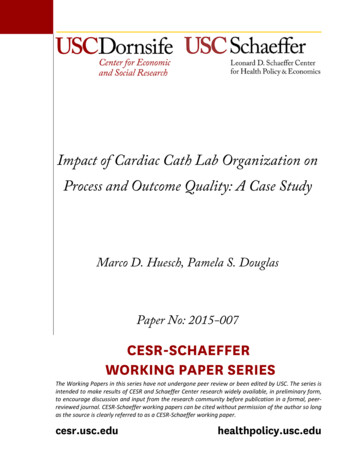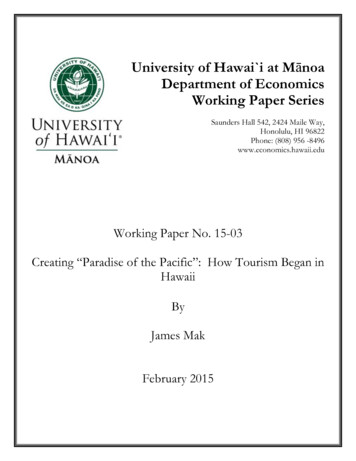
Transcription
Impact of Cardiac Cath Lab Organization onProcess and Outcome Quality: A Case StudyMarco D. Huesch, Pamela S. DouglasPaper No: 2015-007CESR-SCHAEFFERWORKING PAPER SERIESThe Working Papers in this series have not undergone peer review or been edited by USC. The series isintended to make results of CESR and Schaeffer Center research widely available, in preliminary form,to encourage discussion and input from the research community before publication in a formal, peerreviewed journal. CESR-Schaeffer working papers can be cited without permission of the author so longas the source is clearly referred to as a CESR-Schaeffer working paper.cesr.usc.eduhealthpolicy.usc.edu
Impact of Cardiac Cath Lab Organization on Process and Outcome Quality: A Case StudyMarco D. Huesch, University of Southern CaliforniaPamela S. Douglas, Duke UniversityAbstract.Quality improvement must balance two conflicting objectives: process conformance and process reengineering. Healthcare facility organization structure may favor one approach over the other. Weexamined whether cardiac cath labs that are open [permitting operators to work at other sites] orclosed achieve faster door-to-balloon times [D2B] and lower in-hospital mortality. We usedretrospective secondary data from the Massachusetts Department of Public Health on all 30,903 cathlab visits involving a percutaneous coronary intervention [PCI] in 4/1/03-12/31/04. Patient-levelmodels were estimated for in-hospital mortality in all patients, and for D2B time in ST-segmentelevation myocardial infarction [STEMI] patients, accounting for patient risk, hospital and operatorPCI procedural volume.The parameters of interest were the effects of a lab’s closed status or the by the mean number of labswhere an open lab’s operators worked across. In unadjusted analyses, the patients of closed labs hadlower in-hospital mortality (1.0% vs. 1.7%, P .001), and their STEMI patients had longer medianD2B times (96 vs. 73 minutes, P .001). The more open a lab, the faster were D2B times and thehigher the proportions of patients meeting D2b thresholds (trend, P .001). Procedural experience wasnot consistently related to mortality outcomes. In adjusted analyses, STEMI patients of closed labshad lower odds of timely PCI 30 min (P .05) and 60 min (P .01); the more open a lab, the betterthe odds (all, P .001). In hierarchical mixed models, STEMI patients continued to have lower oddsof PCI 30 min (P 0.064) and 60 min (P .05) the more open their labs were.Patients of closed and less open cath labs in Massachusetts were less likely to receive timely PCI, butnot more or less likely to die in hospital. Hospital and operator PCI experience was inconsistentlyassociated with D2B times. This case study’s findings support a broader search for the successfactors of PCI quality beyond experience or site processes towards aspects of a lab’s organization andstaffing pattern.1
INTRODUCTIONWhat should healthcare facilities learn and how should they go about it? The CEO of one largeBoston hospital regularly articulated his organization’s relentless focus on learning to improvesafety and quality (Levy, 2010). However, such improvement efforts face a key conflict (Tuckerand Edmondson, 2002). Hospitals must learn to standardize as much as possible to avoidvariability. Yet on the other hand, they must intervene, address root causes and invent newapproaches. The two goals thus trade-off conformance against experimenting and re-engineering.Recognizing this paradox, organizations balance perfecting existing practices withlearning new practices (March, 1991; Raisch et al., 2009). Binding constraints on time, humancapital, financial capital and other resources, may cause the trade-off between conflictinglearning objectives to be reflected in resource allocation and structure decisions. For example,some organizational designs should be better suited to one or the other learning objective (Marchand Simon, 1958; Williamson, 1991). In practice, healthcare organizations with similarobjectives may reach divergent designs (Alexander et al., 1996; Burns and Thorpe, 1997).In this case study, we explore the relationship between one aspect of organizationalstructure – physician staffing practices – and performance in cardiac catheterization laboratories[cath labs] performing percutaneous coronary interventions [PCI]. In cardiac care, theperformance imperative is to reduce variability and improve the end outcome (Krumholz et al.,2007; Krumholz et al., 2008; Shailja et al., 2009). Outcome measurement (Douglas and Brindis,2006) and process improvement are important precursors (Werner and Bradlow, 2006) ofimproved patient outcomes (Dehmer et al., 2004; Rathore et al., 2009).Such collaborative process design efforts and inter-disciplinary team work have beenshown to improve door-to-balloon [D2B] times (Bradley et al., 2006; Bradley et al., 2007) and2
enhance evidence-based discharge therapy (Bradley et al., 2001). Much prior quantitativeresearch has also focused on independent attributes of cardiologists (Artis et al., 2006) orhospitals (McNamara et al., 2006), especially in terms of procedural experience and its benefits(Smith et al., 2006) and how different combinations of operator experience or hospitalexperience might affect PCI outcomes (Ryan, 1995; Vakili and Brown, 2003). Surveys and otherqualitative work such as case studies have also attempted to isolate the key factors that allowsome hospitals to succeed in collaborative process design efforts and inter-disciplinary teamwork (Bradley et al., 2006; Bradley et al., 2007).Yet to our knowledge, no prior research has examined the key organizational structurefeature of whether the lab is ‘open’ or ‘closed’, and whether its cardiologists ‘roam’ or not.Anecdotally, a closed lab in which all operators only perform in that lab is thought to be themore effective model in producing quality outcomes. We review the clinical, managementscience and organizational literature and develop hypotheses for which design form is expectedto be best suited to which type of organizational learning.We test these hypotheses in a case study of all cath labs in Massachusetts using rich,clinically audited chart data of all PCI lab visits that occurred in every adult admission inMassachusetts between 4/1/2003 and 12/31/2004. Given the small, short panel, we aim to initiatea discussion in the field on an important, under-studied determinant of health care outcomes.BACKGROUNDIn this section we sketch a conceptual model (Figure 1) relating decisions on organization designand physician staffing practices with hospital performance. We summarize the key constructsand then develop our hypotheses.3
PCI procedural and process successSuccessful PCI (Smith et al., 2005) is defined in angiographic, procedural (no major in-hospitalclinical complications) and clinical ways (persistent relief of signs and symptoms of myocardialischemia for at least 6 months). One key procedural outcome is in-hospital mortality (Masoudi,2007; Krumholz et al., 2008) which averages less than 1.5% in registry studies, and near 5% inST-segment elevation myocardial infarction [STEMI] patients (Peterson et al., 2010). Proceduralsuccess in PCI is thought to be related to process success, in particular rapid intervention inSTEMI patients following onset of symptoms (Brodie et al., 2001; McNamara et al., 2006).Organizational capabilities and type of learning requiredThe interventional cardiologist develops individual expertise and works in concert with otherphysicians and multiple other front-line staff inside and outside the lab. A successful lab musttherefore coordinate internally (e.g. scheduling, training, operational checklists) and alsocoordinate externally across the lab/hospital organizational boundaries. Collaborative efforts toenhance evidence-based processes of care improve outcomes in cath labs (Bradley et al., 2001;Bradley et al., 2006; Bradley et al., 2007) as well as intensive care (Gawande, 2007), and criticalcare (Hales and Pronovost, 2006).To improve on PCI procedural and process measures labs may learn on two separatedimensions. One dimension reduces systematic variability by ensuring conformance todocumented processes and roles documented in best practice guidelines. The other deliberatelyincreases systematic variability by allowing and encouraging re-design of sub-optimal processes,roles and responsibilities. These dimensions may conflict, since ensuring conformance to aflawed process is as poor an organizational behavior as allowing tinkering with an optimized4
process. Analogously, patching or papering over a broken system (Tucker and Edmondson,2002) is a much more short-term solution than deep problem solving involving root causeanalysis (McDuffie, 1997; Repenning and Sterman, 2002).Interaction of PCI objectives, capabilities and organizational learningGiven the multi-factorial etiology underlying an unsuccessful procedure or adverse in-hospitalclinical event, we conjectured that improving PCI in-hospital mortality would require all of thelabs capabilities and both forms of learning. However, for the reduction of D2B times, weconjectured that the key capabilities were more likely to be external coordination between the laband emergency department, and internal coordination within the lab (e.g. on-call staffing) ratherthan individual clinical expertise.1 We postulated that the type of learning required for D2Breduction would tend more towards process conformance rather than reconfiguration.Cath lab staffing practicesCath lab physician staffing practices vary along a continuum from ‘open’ to ‘closed’ labs inwhich all physician operators are restricted to working just at that site. In an open lab, individualoperators may rotate through one or more labs.There is no guidance on how such differences in staffing practices might affect labcapabilities, moderate the lab’s ability to learn, or ultimately affect PCI success. Organizationalresearch on the impact of employee turnover suggests new employees allow the influx of newknowledge into an organization, particularly valuable when knowledge is not well-codified(March, 1991; Dokko and Rosenkopf, 2010; Pierce and Snyder, 2008). Work across multiplelocations may thus allow physicians to acquire experience that benefits their patients at other5
hospitals although there is no strong empirical evidence for (Huckman and Pisano, 2006) andscattered evidence against this (Carey et al., 2008). FIGURE 1 ABOUT HERE However, in open labs with many roaming cardiologists the operational complexity of thelab may increase. Coordination of tasks, technology and workers may suffer if familiarity withother team members is lower (Huckman, Staats and Upton, 2009). Familiarity with co-workers isan in important driver of psychological safety, so knowledge sharing may also be reduced(Siemsen et al., 2009). Similarly, coordination may suffer if there is decreased familiarity withorganizational routines (Nelson and Winter, 1982) which embed knowledge of how to perform atask into codified repositories (Cohen and Levinthal 1990). For example, in settings such asfront-line retailing where operations require high process conformance, employee turnovernegatively impacts firm performance (Ton and Huckman, 2008).HypothesesIn line with prior research into the effect of human resources practices on industrial production(Ichniowski et al., 1997), we hypothesized that lab organization and design differences wouldsupport or obstruct the hospital’s different PCI objectives. In particular, we conjectured that openlabs would be more likely to facilitate the transfer of new ideas and the development of newindividual expertise originating in other labs, while closed labs would be more likely to achievehigh levels of process conformance and have enhanced coordination within and without the lab.6
Based on our discussion of the different capabilities and types of learning required forachievement of the two PCI quality objectives of lowering mortality and hastening interventions,we therefore expected to observe the following:H1: In-hospital PCI mortality will not differ by physician staffing practices.H2a: Door-to-balloon times will be faster in closed labs than in open labs.H2b: Door-to-balloon times will be faster in less open labs than in more open labs.ANALYTICAL STRATEGYPatient populationOur case study data were obtained from the Massachusetts Department of Public Health,2 andincluded all 30,903 distinct visits to a cath lab for a percutaneous coronary interventionperformed during 29,808 distinct admissions on 26,397 distinct patients aged 18 years or older inMassachusetts state-regulated acute care hospitals between April 1, 2003 and December 31,2004.3 Mass-DAC, the administrator of the data, collects and audits the data using ACC-NCDRversion 2.0 and 3.0 forms.Dependent VariablesWe measured intervention timeliness for STEMI patients for their first lab visit during theiradmission, using the continuous variable of D2B in minutes or dichotomous indicators of D2B7
time 30, 60 or 90 minutes.4 We included incoming transfer patients and perform additionalsensitivity analyses to understand the impact of differences in the proportion of transfer patientsat a lab (Nallamothu et al., 2007).All patients had in-hospital mortality measured.Control VariablesWe extracted 38 demographic, pre-visit co-morbidities, clinical factors and angiographiccovariates (Peterson et al., 2010; Douglas et al., 2009; Anderson et al., 2007), and year ofadmission. The Mass-DAC data were highly complete. We set all missing binary elements in thepatient’s past medical history to ‘no’ or ‘not present’. We used single imputation methods toimpute values for BMI, using the gender-specific median. We employed a different approach formissing values of ejection fraction (Peterson et al., 2010).5 We validated discrimination of thisdata in a conventional logistic regression on in-hospital death (see Supplementary Material), andfound a C-index of 0.93 in line with other recent investigations using ACC-NCDR data (Petersonet al., 2010). All control variables are used in all models.Statistical AnalysesThe central hypotheses of this study posit different procedural and process outcomes for differentpatients based on the closed/open staffing characteristics of the cath lab in which they underwentPCI. To operationalize this, we specified a multivariate adjusted logistic relationship between thefocal independent variables STAFFINGi and the dependent variable yi for each patient indexed i,receiving PCI at cath lab h, performed by operator c:y*ich α β STAFFINGi γ1 Xi γ2 Xc γ3 Xh δ εi ;τεi Λ(0, π2/3)8
Pr{yich 1 covariates} Pr{ y*ich 0} α β STAFFINGi γ1 Xi γ2 Xc γ3 Xh δ )τWe controlled for independent patient Xi risk factors at the time of admission, describedfurther below. We also controlled for operator Xc and cath lab Xh factors such as number ofoperators practicing at the lab and individual procedural experience that might moderate therelationship of interest (Silber et al., 2010). To compute these, we used the stabilized averagemonthly PCI caseload observed over operator or lab panel participation.The STAFFING variables were defined in two ways and used in separate analyses. First,we constructed a binary indicator for closed labs by identifying labs in which all their operatorswere observed to work only at that lab during the case study period. Second, since most labswere open and differed in the extent to which they were open, we also constructed a continuousmeasure at the lab level which represented the average number of hospitals at which a lab’soperators worked to capture the extent of openness of most of the labs. Individual operatorsworked up to a total of 5 labs. Aggregated at the cath lab level, the continuous measure of labopenness ranged from 1 (i.e. closed) through 2.5 in our data.We expect correlation of outcomes within operators or labs, and specify robust standarderrors in conventional logistic regressions allowing for this clustering by operators or by labs. Inhierarchical mixed models we separately add random effects at the operator or lab level enteringthe procedural volume covariates and STAFFING variables as fixed effects and adding randomintercepts for the cath labs (Peterson et al., 2004; Austin et al., 2004; Silber et al., 2010).6We used two-tailed tests of significance throughout, made no correction for multiplecomparisons (Rothman, 1990) and considered P 0.05 to be statistically significant. The healthsystem institutional review board at [the authors’ institution] approved this study.9
FINDINGSThe 14 non-pilot hospitals examined in this case study had a mean monthly PCI proceduralvolume of 104.5 (range 29.6 – 172.9), while the 128 PCI operators studied had a mean monthlyPCI procedural volume (including at pilot program hospitals) of 12.4 (range 1.0 – 49.6).7 Wereport the distribution of procedural volume in detail in the Supplemental Material and show theabsence of a consistent relationship of lab and operator procedural experience with process andprocedural outcomes. There is substantial crossing of operators with hospitals: 38 of the 128operators worked across 2 or more sites. A large number of hospitals have multiple distinctoperators on site over the course of the study: 9 hospitals have more than 10 distinct operatorsperforming PCI in their labs. TABLE 1A ABOUT HERE In Table 1a we describe the demographic, comorbidity, cardiac status and angiographiccharacteristics of the PCI patients, categorized by whether or not the lab was completely closed.In the left columns we show data on all patients, and on the right for just STEMI patients. Onmost clinically relevant variables, the labs differed significantly by staffing practice. Closed labssaw a higher proportion of sicker patients but had more benign angiographic features with alower proportion of patients with SCAI IV lesions, left main disease or significant proximal leftanterior descending lesions.8Closed labs tended to be significantly less busy than open labs, had slightly feweroperators on service, and their operators tended to perform fewer PCI than the operators of labswhich were not closed. Overall, labs that were open had operators who rotated through 1.7 labs10
in total; the same statistic is by definition 1 for closed labs. Associated with the different staffingpractices, the lower panel of Table 1a shows unadjusted process and procedural outcomes.Compared to open labs, closed labs had 24 minutes longer median D2B time, and a 1.7% pointlower unadjusted in-hospital mortality rate. Results for STEMI patients only are similar (Table1a, right-hand columns; see Supplementary Material for additional results).In Table 1b we show the generally increasing and highly significant trend of longermedian D2B time as the lab becomes progressively more closed, culminating in the 96 minutestime in a completely closed lab. The patients of closed labs are far more likely to fail to receivePCI within even 450 minutes (19% vs. 5.0 – 12.6% for variously open labs, trend, P .001).Figure 2 plots these gradients for achievement of the 30, 60 and 90 min thresholds, againon unadjusted measures. These unadjusted analyses thus fail to reject H1, while presentingevidence against H2a and H2b. TABLE 1B AND FIGURE 2 ABOUT HERE Adjusted AnalysesIn Table 2 we report the marginal effects of the key STAFFING variables, controlling for patientrisk (estimates suppressed) and procedural volume by operator and lab to control for possiblelearning or scale effects independent of lab staffing practices. In the top panels of Table 2 weshow the estimates of staffing practices on D2B 30 min, 60 min and 90 min. In the bottompanel we report the effect on in-hospital mortality.In our preferred specifications accounting for likely clustering of patient-leveldisturbances by hospital we again find evidence against both H2a and H2b, but fail to reject H1.11
The binary indicator for a closed lab was associated with a significant reduction in the likelihoodof STEMI patients receiving PCI within 30 minutes (adjusted odds ratio [OR] 0.40, P .05) orwithin 60 minutes (OR 0.56, P .01). Using a continuous measure of the extent to which a lab isopen showed that a large increase by 1 in the mean number of labs that a lab’s operators rotatethrough was associated with more than doubling of the odds of timely PCI (all, P .001). Nomarginal impacts on in-hospital mortality were found. Table 2 also shows the lack of substantialimpact of lab or operator procedural experience on process or mortality outcomes (seeSupplementary Material for additional results). TABLE 2 ABOUT HERE Sensitivity AnalysesWe subjected our analyses to several sets of sensitivity analyses to understand the robustness ofour specification, identification and estimation strategies.In unreported analyses, we specified a relationship between the predictors of interest andvarious quantiles of the D2B times for STEMI patients. Using multivariate adjusted quantileregression, a binary indicator for a closed lab was associated with an increase of 26.9 minutes inthe median D2B time (P .001), 16.1 minutes in the fastest quartile (P .001), and 12.4 minutes inthe slowest quartile of D2B times (P .05).Using the continuous measure of the extent of lab openness, an increase by 1 in the meannumber of labs that a lab’s operators rotated through was associated with a reduction in themedian D2B time by 34.1 minutes, the fastest quartile by 19.6 minutes, and the slowest quartile12
by 32.6 minutes (all, P .001). These alternative specifications thus yielded results similar to theearlier logistic regressions on thresholds of D2B times.In other unreported analyses, we specified a multivariate adjusted linear probabilitymodel for the event of in-hospital death for all admission in a non-pilot hospital. SpecifyingHuber-White sandwich estimated robust standard errors, a closed lab was associated with areduction in the probability of death by 0.45% points (P .05), while an increase by 1 in the meannumber of labs that a lab’s operators rotated through was associated with an increase in theprobability of death by 0.42% points (P .05). Specifying cluster-robust standard errors toaccount for likely clustering of patient outcomes within labs, the point estimate on closed labsremained significant at P .05, but the estimate of an increase in openness was no longersignificant at conventional levels (P .149).We also considered that differences in the proportion of transfer patients could confoundour analyses of the impact of staffing practices. Transfer patients have a greater elapsed timefrom first presentation at the source hospital to cath lab procedure at the recipient hospital(Gibson et al., 2008). However, the D2B performance measure only commences on arrival at thedestination hospital, by which time data acquisition and lab activation may already haveoccurred. Accordingly we expect and find lower D2B times for transfer patients compared to EDadmissions and referrals (median 56 vs. 93 minutes, P .001). TABLE 3 ABOUT HERE In our data, closed labs had significantly fewer transfer patients than open labs (51.8% vs.56.1%, P .05), and we were concerned that staffing variables might be spuriously correlated13
with these differences. Accordingly, we re-estimated conventional logistic regressions withrobust standard errors on non-transfer and transfer STEMI patients separately (Table 3) butfound very similar results across the different samples.Our identification strategy relies on cross-sectional variation in staffing variables, so isnot immune to unmeasured confounding. To ascertain the sensitivity of our results to one type oftime-invariant unmeasured confounding at the hospital or operator level, we specifiedhierarchical mixed models whose fixed part was identical to the conventional logistic models inTable 2, but adding random intercepts for the hospitals or operators (Pietz et al., 2002; Bronskillet al., 2002; Ferraris et al., 2008).We note that the assumptions required for consistent estimation of these models may notbe fully met in our data. In particular, there are not many clusters, and in one small state thepatient-level disturbances may not be completely uncorrelated across hospitals. TABLE 4 ABOUT HERE Nevertheless, using the hierarchical models to control for such unmeasured confoundinghad small effects on the point estimate magnitudes, but greatly expanded the confidence intervalsfor the estimates of interest (Table 4). Unobserved factors that were correlated with staffingvariables appear to have had independent impacts on process and procedural success. Controllingfor these rendered the previously precisely estimated impacts of closed lab status insignificant,and reduces the significance level of the continuous measure of openness from P .001 to P .10and P .05 respectively for the key 30 minute and 60 minute thresholds.14
DISCUSSIONWe had expected that closed cath labs would achieve faster door-to-balloon times, while notdiffering on in-hospital mortality compared to open labs. These hypotheses were informed byorganizational learning research in other industries, research into the types of qualityimprovement, and institutional detail on lab capabilities required for PCI successUnexpectedly, our process success hypothesis was rejected. Rather than achieving fasterD2B times, closed labs had worse intervention timeliness. This result was confirmed when usinga continuous measure of openness. We found a gradient in which more open labs had faster D2Btimes than less open labs. In-hospital mortality did not differ meaningfully or consistently withstaffing practices, supporting our procedural success hypothesis.To explicate these results, we return to the conceptual model of Figure 1. With respect toachieving faster D2B times, we had argued that the team capabilities of coordination within andbeyond the boundaries of the lab would be more important that individual expertise, and that thetype of learning which seeks to reduce variability would be more important than that whichsupports experimentation. Closed labs – in our judgment – would have supported thosecapabilities and that type of learning and would thus drive process success.Our failure to find empirical support for this could be due to limitations in our data andanalytical strategy discussed below. Alternatively, one or more of the following threeexplanations may underlie our unexpected results. First, the assumed development of individualexpertise that may result from operator rotation through other clinical settings may be moreimportant than we had thought. Second, the assumed lack of familiarity with lab knowledge andhospital staff among operators in open labs may not be sufficiently adverse to affect coordinationcapabilities.15
Third, if it is more important to intervene and change a flawed process than to ensureconformance with it, then an open lab with physicians who work at other labs, have a wider setof comparators, and have less institutional pressure to conform with an existing practice may dobetter than closed labs. Any of these possible explanations – if supported by additional studies –have clear implications for quality improvement.In our ancillary results we failed to find consistent evidence procedural volume effects.Similar non-linearity in relationships between volumes and process compliance has been foundmore generally (Williams et al., 2008), as has heterogeneity in outcomes among cath labs ofsimilar size, suggesting that site volume alone is an insufficient proxy for quality (Epstein et al.,2004). Since some of these strategies involve discrete events such as having an attendingcardiologist on site at all times (Bradley et al., 2006), continuous relationships betweenprocedural volumes and outcomes are less likely to be identified in quantitative analyses.LimitationsOur case study has a number of important limitations. Most fundamentally, validity is restrictedto one small state over a short period. Second, our data did not permit evaluation of clinicalsuccess such as follow-up for revascularization for restenosis, or longer-term mortality and majormorbidity endpoints. Third, we have made a number of key assumptions in specifying therelationship between key predictors and outcomes, in our identification strategy, and in ourmodes of inference. We acknowledge that each has drawbacks, but undertook a number ofsensitivity analyses to ascertain robustness of results to some of these assumptions.We did not control for possible reverse causation or other time-varying unmeasuredconfounding. If patients are preferentially drawn to particular sites or operators based on16
(unobserved) factors that are correlated with provider quality or ability then our results would bebiased. However, we judged it less likely that patients or emergency medical services transportsare systematically aware of door-to-balloon times, for example, and do or can use suchinformation to make decisions about site options.Of equal concern, if cath lab staffing practices are a response to existing processproblems, then a closed lab could be a consequence instead of a cause of performance. Theconsistent ‘dose response’ gradient seen with the continuous measure of openness mitigates thisconcern somewhat: it seems unlikely that lab and hospital management as well as lab operatorscould coordinate on and calibrate the degree of openness of their lab with its particularperformance level. However in a dataset which lacks exogenous sources of changes in labstaffing patterns and lacks plausibly exogenous measures of procedural experience, we are notable to rule out omitted variable biases.Fourth, we do not know how long elapsed between the patient’s first o
closed achieve faster door-to-balloon times [D2B] and lower in-hospital mortality. We used . (McNamara et al., 2006), especially in terms of procedural experience and its benefits (Smith et al., 2006) and how different combinations of operator experience or hospital . research on the impact of employee turnover suggests new employees allow .










